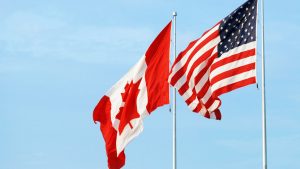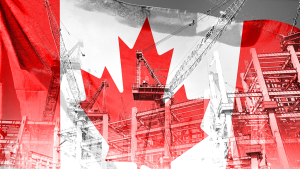The current down cycle for raw materials world-wide is presenting Canada with economic problems. The global price of oil has been halved and most metal and mineral prices are in the doldrums.
The nation’s economy is sputtering. ‘Real’ (i.e., inflation-adjusted) gross domestic product change in the first two quarters of this year was mildly negative, although industry-based GDP rose 0.5% in June.
The weakness in output levels is occurring at a time when the nation is heading into a federal election. Of course, the party leaders aspiring for the country’s top position are eager to tell anyone who will listen their views on what course of action is needed for the economy.
Their proposed options range from: universal day care; to greater spending on infrastructure; to holding the line on government finances.
But there’s also an increasing body of opinion coming from private business and academic circles offering prescriptions to cure what might be ailing Canada.
Much of it relates to finding other means to propel growth, since commodity markets – especially in oil and natural gas – have shown they’re not always reliable.
If I may be so bold, the following is my summary of the best solution being offered more or less at this moment: that Canadians should strive for a better-balanced economy through innovation and efficiencies up and down the value-added goods and services supply chain.
While the foregoing may be a mouthful, there can’t be much doubt about its truth. (And yet, I’ll come to qualifications in a moment.)
Even at an individual employee level, we all now have a responsibility to find the most productive way to do our jobs, working in tandem with owners/management to promote desirable results.
This approach places a premium on acquired knowledge and quick wits − in other words, brainpower.
I have no quarrel with this, but I would like to put forward several related sets of observations and let’s see where they lead.
To begin with, the two most important words appearing in the ‘best answer’ above are innovation and efficiencies.
While not suggesting anyone should be looking for easy answers, it’s still valid to ask, “Can they be bought?”
Upon reflection, the answer – and this surprised me at first – is an emphatic Yes!
As a business owner, you can go out and hire a really great manager. (Better that he or she be developed from within the organization, but if that’s not happening, there is the option to reach outside for talent.)
And/or you can purchase machinery and equipment that will greatly enhance your company’s goods or services business operations.
The personnel hunt, however, may take you outside the country, with U.S. executives as a primary pool.
Similarly, many Canadian M&E purchase orders are placed with American suppliers.
Currently, though, there’s a considerable obstacle to both of these activities, a ‘loonie’ valued at only 75 cents to the greenback.
Bad luck on the timing, Canada…
Second, while the italicized ‘best answer’ is clearly true, it has also always been true. And it will continue forevermore to be true.
Every governing body in every nation knows this.
The headline on the cover of the Economist magazine a couple of weeks ago was, Set Innovation Free.
That doesn’t mean Canada, with its highly-educated labour force, shouldn’t be able to meet and beat the competition in much of the rest of the world.
With everyone knowing the key to success, though, the task is formidable.
The essential consideration then becomes, “Where does Canada have a natural advantage?”
Before answering that question, there are some interesting sidetracks to be explored.
What sets the U.S. economy apart? Simply take a gander at accompanying Chart 1 (shows the names of Apple, Amazon, Google, Microsoft, etc.). No other nation has anything like the concentration of firms engaged in knowledge-based activities. (Okay, maybe Taiwan and India are headed in that direction.)
Canada does have brainpower hubs, most notably in Toronto, Montreal, Vancouver, Ottawa-Gatineau and Kitchener-Waterloo.
And there are some rising Internet stars north of the border, such as Hootsuite and Shopify − or if an expansion of the digital/biomedical/communications circle is warranted, CGI Group (a Montreal data software giant), Valeant Pharmaceuticals, CAE (flight simulators) and Cinram (CDs).
But none, so far, has made us forget the skyrocketing flight, then disintegrating orbit of Blackberry Limited.
To what degree might a turnaround in Canada’s auto sector come to the rescue? The industry is experiencing turbo-charged consumer demand from domestic and export customers.
Nevertheless, Table 1 highlights a major difficulty to be overcome.
These are no longer the halcyon days of the Auto Pact. Mexico, with unapproachably low labour costs, now accounts for 30% of U.S. auto sector imports, versus Canada’s 17%. Canada is not likely to win back market share.
To repeat, “Wherein lies Canada’s natural advantage?”
Once you ask that question, you inevitably and inexorably loop around back to your starting point, natural resources.
Furthermore, it’s bad strategy to set aside, overlook or undervalue inherent strengths.
Raw materials will continue to provide the underpinnings to drive Canada’s economy. The high-jump bar for clean-extraction, though, has been raised and Canadian firms must not only clear it, they must convince skeptical elements within society of their achievements.
Bottom line: how would I sum up the above musings on a solution to Canada’s current economic woes?
I’m not trying to deliver too heavy-handed a message here. After all, the ‘best answer’ highlighted earlier in this Economy at a Glance can hardly be faulted.
What I am pointing out is that, for whichever party wins the Prime Ministerial vote on October 19, subsequent public policy action should not swing too precariously off course in search of some idealized, or maybe even romanticized, ‘balance’.
| Passenger Cars | Light Trucks, etc. | |||||
| 1 | Canada | 24% | 1 | Mexico | 83% | |
| 2 | Japan | 22% | 2 | Canada | 7% | |
| 3 | Germany | 15% | 3 | U.K. | 2% | |
| 4 | Mexico | 14% | 4 | Japan | 2% | |
| 5 | S Korea | 11% | 5 | China | 1% | |
| Auto Parts | Total | |||||
| 1 | Mexico | 35% | 1 | Mexico | 30% | |
| 2 | China | 13% | 2 | Canada | 17% | |
| 3 | Canada | 12% | 3 | Japan | 15% | |
| 4 | Japan | 10% | 4 | Germany | 10% | |
| 5 | Germany | 8% | 5 | S Korea | 8% | |
Table: CMD










Recent Comments
comments for this post are closed